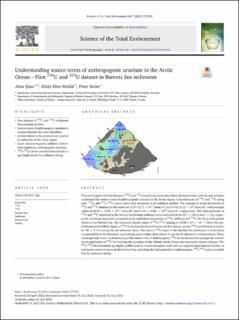| dc.contributor.author | Qiao, Jixin | |
| dc.contributor.author | Heldal, Hilde Elise | |
| dc.contributor.author | Steier, Peter | |
| dc.date.accessioned | 2022-10-19T11:30:37Z | |
| dc.date.available | 2022-10-19T11:30:37Z | |
| dc.date.created | 2022-09-28T12:49:11Z | |
| dc.date.issued | 2022 | |
| dc.identifier.citation | Science of the Total Environment. 2022, 847 . | en_US |
| dc.identifier.issn | 0048-9697 | |
| dc.identifier.uri | https://hdl.handle.net/11250/3027052 | |
| dc.description.abstract | This work reports the first dataset of 236U and 233U in sediment cores taken from the Barents Sea, with the aim to better understand the source terms of anthropogenic uranium in the Arctic region. Concentrations of 236U and 233U along with 137Cs, and 233U/236U atomic ratio were measured in six sediment profiles. The cumulative areal inventories of 236U and 233U obtained in this work are (3.50–12.7) × 1011 atom/m2 and (4.92–21.2) × 109 atom/m2, with averages values of (8.08 ± 2.93) × 1011 atom/m2 and (1.08 ± 0.56) × 1010 atom/m2, respectively. The total quantities of 236U and 233U deposited in the Barents Sea bottom sediments were estimated to be 507 ± 184 g and 7 ± 3 g, respectively, which are negligible compared to the total direct deposition of 236U (6000 g) and 233U (40–90 g) from global fallout in the Barents Sea. The integrated atomic ratios of 233U/236U ranging in (0.98–1.57) × 10−2 reflect the predominant global fallout signal of 236U in the Barents Sea sediments and the highest reactor-236U contribution accounts for 30 ± 14 % among the six sediment cores. The reactor-236U input in the Barents Sea sediments is most likely transported from the European reprocessing plants rather than related to any local radioactive contamination. These results provide better understanding on the source term of anthropogenic 236U in the Barents Sea, prompt the oceanic tracer application of 236U for studying the dynamics of the Atlantic-Arctic Ocean and associated climate changes. The 236U-233U benchmarked age-depth profiles seem to match reasonably well with the reported input function history of radioactive contamination in the Barents Sea, indicating the high potential of anthropogenic 236U-233U pair as a useful tool for sediment dating. | en_US |
| dc.language.iso | eng | en_US |
| dc.title | Understanding source terms of anthropogenic uranium in the Arctic Ocean – First 236U and 233U dataset in Barents Sea sediments | en_US |
| dc.title.alternative | Understanding source terms of anthropogenic uranium in the Arctic Ocean – First <sup>236</sup>U and <sup>233</sup>U dataset in Barents Sea sediments | en_US |
| dc.type | Peer reviewed | en_US |
| dc.type | Journal article | en_US |
| dc.description.version | publishedVersion | en_US |
| dc.source.pagenumber | 11 | en_US |
| dc.source.volume | 847 | en_US |
| dc.source.journal | Science of the Total Environment | en_US |
| dc.identifier.doi | 10.1016/j.scitotenv.2022.157503 | |
| dc.identifier.cristin | 2056339 | |
| cristin.ispublished | true | |
| cristin.fulltext | original | |
| cristin.qualitycode | 2 | |
